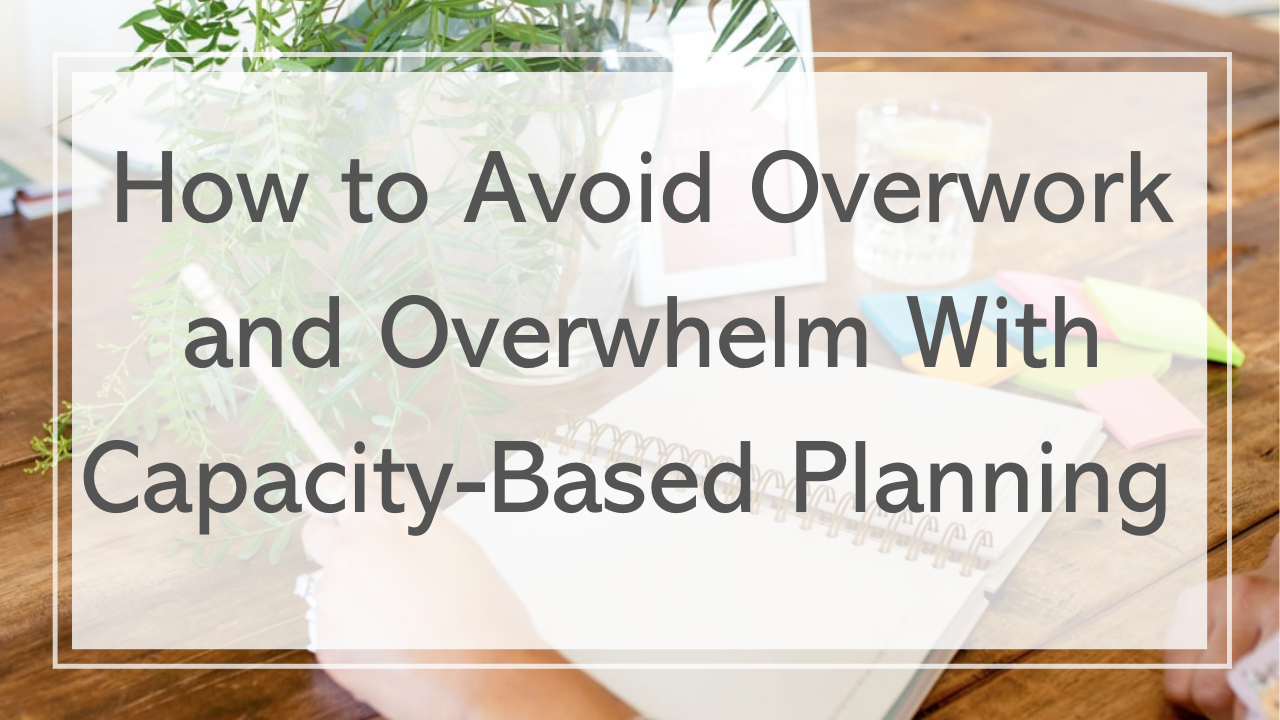
Want to avoid unexpected overwork and overwhelm as you plan for the second half of the year?
Making capacity based commitments (aka capacity based plans) is the answer.
TIP: Leverage these steps yourself and have your team do the same.
First, you want to get clear on what your capacity is.
How much do you want to work each week? Is it 40 hours a week, less or more?
For example purposes, let's say it's 40 hours per week.
That means that as you are developing your lean strategic plan, you are only committing to the things that can be done within that capacity.
And here's the important thing - you're not committing to things that can be done in 100% of your capacity, but only 70% of your capacity.
So if you are developing your plan for a 40 hour week, you would only commit to things that can be done in 28 hours.

Why 70%?
You want to leave space for the unexpected and for things taking longer than you thought they would.
Because let's face it. Things frequently take longer than we expect, especially if it's something new we have no benchmark for. And there are always unexpected things that come up, sometimes things we wish didn't come up and sometimes amazing opportunities!
We need the protected space in our schedule for them or else we end up overworking or missing commitments which can impact our motivation and leave us feeling frustrated and discouraged.

Does it have to be 70%?
No, and over time you may actually want to increase the amount of space you have in your schedule, especially as you expand your team and align your work to exclusively be focused on your Zone of Genius activities.
But 70% is a good place to start.
You also want to be really intentional with your time and your commitments.
Instead of creating a to-do list a mile long and that can never be accomplished within a week and setting yourself up for disappointment from the start of the week, be strategic with what you invest your time into.
Focus on the highest priority activities first.
These are usually delivering on client commitments, and goal-aligned projects and marketing campaigns. This should also include time working ON your business.
Then add in other things you could do that align to your goals but that aren't critical for this week.
On the very rare occasion that you have time left over at the end of the week, pull your next most important item from your backlog to work on.
Without leveraging capacity-based commitments, a planned 40 hour work week can easily turn into 60+ hours which is a recipe for overwork and overwhelm.

Here is your 5-step recipe for avoiding overworking by leveraging capacity based planning:
1. Establish your capacity
2. Create a prioritized backlog that includes your:
- Highest priorities & must-do activities
- Other goal-aligned things you could do
3. Create a capacity-based plan, only committing to 70% of total capacity
4. If there happens to be space left at the end of the week, celebrate that you accomplished the most critical and needle-moving activities for the week - yay! - and then pull your next highest priority thing from your backlog
5. Unapologetically say NO to everything else
Tools For Capacity-Based Planning
I love using a combination of my Lean Out Planner and Monday.com.
Monday has my backlog of #allthethings that I put in priority order (it's super easy to move things around digitally), but the only things that go in my planner are the things I commit to and know I can accomplish within my capacity.
There is no better feeling than finishing out a week knowing that you accomplished the things that mattered most and that you did so without having to give up your personal life to do it.
by Crista Grasso
Crista Grasso is the go-to strategic planning expert for leading global businesses and online entrepreneurs when they want to scale. Known as the "Business Optimizer", Crista has the ability to quickly cut through noise and focus on optimizing the core things that will make the biggest impact to scale a business simply and sustainably. She specializes in helping businesses gain clarity on the most important things that will drive maximum value for their clients and maximum profits for their business. She is the creator of the Lean Out Method, 90 Day Lean Out Planner, and host of the Lean Out Your Business Podcast.




